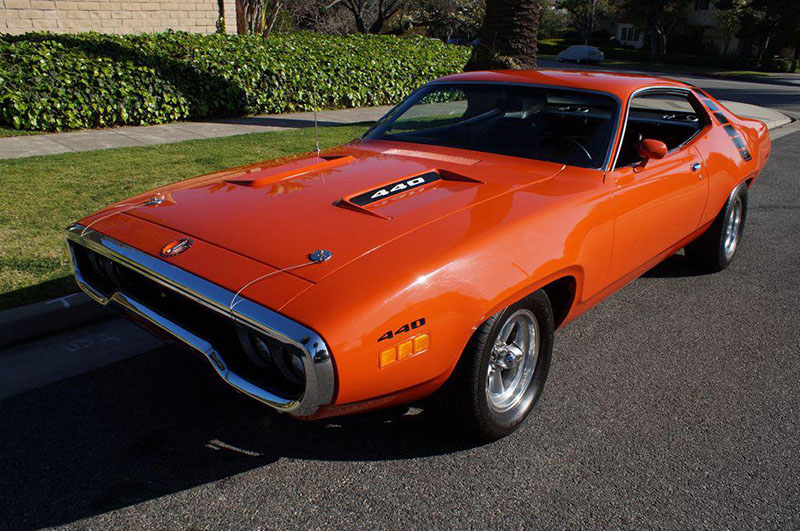
Plymouth Satellite
The Plymouth Satellite is an automobile that was introduced as a 1965 model year top trim model in Plymouth’s mid-size Belvedere line and available only in two-door hardtop and convertible body designs.
The Satellite remained the top of the line model until the 1967 model year
The Fury name was moved to Plymouth’s mid-size models for 1975, at which time the Satellite name was discontinued. The Satellite was built on Chrysler’s mid-size “B” platform.
First Generation (1965-1967)
When the new, larger Plymouth Fury was introduced for 1965 on Chrysler’s full-size C platform, the Plymouth Belvedere name was moved to Plymouth’s “new” mid-size line for 1965.
The Belvedere Satellite was the top model in the series. It was only available as a two-door hardtop or convertible.
Standard Features
The standard features included:
Bucket seats and center console
V8 engine, the standard being the 273 cu in (4.5 L) with optional 318 cu in (5.2 L), 361 cu in (5.9 L), as well as 383 cu in (6.3 L) and 426 cu in (7.0 L) Commando” engines
This 426 had the wedge combustion chamber design
The front end featured single headlights on each side, a grille divided into four thin rectangles laid horizontally.
The 1965 Satellite two-door hardtop total production was 23,341 units.
It weighed 1,460 kg with a base price of $2,612.
Convertible production was 1,860 units.
It weighed 1,508 kg and was priced at $2,827 in standard trim.
1966 Satellite
The 1966 redesigned Satellite had:
“Street Hemi” engine
Two 4-barrel carburettors
10.25:1 compression
This engine was rated at 425 hp (317 kW) at 5,000 rpm and 490 lb·ft (664 N·m) of torque at 4,000 rpm.
The other V8 engine options were:
The 180 hp (130 kW) 273, the 318 at 230 hp (170 kW), and the 265 hp (198 kW) Commando 361 and Commando 383 at 325 hp (242 kW), down from its 330 hp (250 kW) rating in 1965.
1967 Satellite
The 1967 Satellite was a carryover from 1966, but there were several trim changes.
A new grille featured dual side-by-side headlights, a change in the rear trunk finish panel and taillights included multiple horizontal ribs.
New horizontal aluminum trim at the lower body crease with lower silver paint gave all 1967 Satellites essentially a two-tone paint scheme.
For 1966 and 1967, the interior vinyl seats and door panels were treated to a unique ‘Western Scroll’ design which mimicked tooled leather in appearance.
This was the ‘premium’ interior shared with the GTX in 1967. For 1966 and 1967 the Satellite was again offered only in 2-door hardtop and convertible models and was powered by V8 engines.
The 361 was discontinued for the 1967 models, but a 2-barrel 383 producing 270 hp (200 kW) was optional, as well as 4-barrel version rated at 325 hp (242 kW).
Production figures for 1966 were 35,399 hardtops and 2,759 convertibles.
Second Generation (1968-1970)
A restyled and higher trimmed Sport Satellite model with a standard 318 V8 was introduced in 1968, at which time the Belvedere name was relegated to the low-trim base models, Satellite being the mid-level trim line.
The 1968 model year was also the first time that the Satellite line was expanded beyond the 2-door hardtop and convertible, when a 4-door sedan and station wagon were offered.
The 1968 model year was also the introduction of the Plymouth Road Runner that shared the same body as the Satellite and Belvedere models.
The 1968 body continued through 1970, with a minor front and rear restyling for 1970, which was the last year for the Belvedere name.
Third Generation (1971-1974)
A new design was introduced for the 1971 model year.
The Satellite adopted new “fuselage” styling – in line with the facelifts on the larger Chrysler C-Body models – on the two-door, four-door, and wagon models.
Unlike previous years, 4-door sedans and 2-door coupes did not share sheet metal and each carried unique styling.
Sedans were available:
In base
Custom
Brougham trim,
Two-doors were available in base trim (with rear windows that did not roll down)
Sebring trim
Sebring Plus trim
Station wagons were available:
In base
Custom
Wood-trimmed Regent models
Two-door models had a loop-type front bumper
Body was the basis for the related GTX and Roadrunner models.
Plymouth Satellite Sebring
For the 1973 model year, the two-door models – including the Sebring – received more conventional front end and squared up sheet metal and rear side windows
Safety requirements for the 1974 model year included:
5 mph (8.0 km/h) bumpers for the sedans and wagons
The Satellite name was dropped after 1974, after which Plymouth’s intermediate offerings on the B-body chassis took the Plymouth Fury name.
The Satellite Sebring was replaced by the Chrysler Cordoba (a car which was originally intended to be a Plymouth) and shared an all new body with the Dodge Charger
Selling your Plymouth Satellite or want a valuation?
Then please call us today at WCC, we are the no hassle way to sell any classic car including your Plymouth.
As a long time licensed and bonded California auto dealership, we will take care of all the paperwork for the sale of your car ….. properly take care of all the paperwork that is, with no car left still registered in your name; we will give you a fair and no BS immediate cash offer for the car; imagine no advertising costs, no dealing with “tire kickers”, no bad checks, no non-existent wire transfers, no waiting for your money and probably most importantly, no strangers at your home or in your business .. period.
We will also arrange the immediate professional pick up and transportation of your car by a licensed auto shipper from anywhere in the continental United States. Ultimately, we are one of the quickest, safest and easiest way to sell your classic car today.
We have the knowledge and power to execute the deal immediately, so if you want some friendly advice or just a chat about how to sell us your Plymouth Satellite then don’t hesitate to call us on (310) 399-3990 now!
